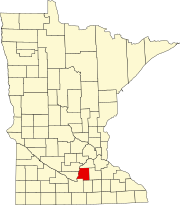Heidelberg, Minnesota
Heidelberg, Minnesota | |
|---|---|
 Location of Heidelberg, Minnesota | |
| Coordinates: 44°30′01″N 93°37′42″W / 44.50028°N 93.62833°W | |
| Country | United States |
| State | Minnesota |
| County | Le Sueur |
| Platted | December 4, 1878 |
| Incorporated | June 26, 1894 |
| Government | |
| • Mayor | Lori Weldon |
| Area | |
| • Total | 0.524 sq mi (1.356 km2) |
| • Land | 0.524 sq mi (1.356 km2) |
| • Water | 0.000 sq mi (0.000 km2) |
| Elevation | 1,053 ft (321 m) |
| Population | |
| • Total | 137 |
| • Estimate (2022)[4] | 132 |
| • Density | 261.45/sq mi (101.01/km2) |
| Time zone | UTC–6 (Central (CST)) |
| • Summer (DST) | UTC–5 (CDT) |
| ZIP Code | 56071 |
| Area code | 952 |
| FIPS code | 27-28214 |
| GNIS feature ID | 2394346[2] |
| Sales tax | 7.375%[5] |
| Website | cityofheidelbergmn.com |
Heidelberg is a city in Le Sueur County, Minnesota, United States. The population was 137 at the 2020 census.[3]
Geography[edit]
According to the United States Census Bureau, the city has a total area of 0.524 square miles (1.36 km2), all land.[1]
County Highway 28 serves as a main route in the community. Minnesota State Highway 13 passes nearby.
History[edit]
Heidelberg was platted on December 4, 1878, and named by its original German settlers (Frank Heil and Frederick Ihrig) after Heidelberg, in Germany.[6] A post office operated in the community from 1872 until 1903.[7] Heidelberg was incorporated on June 26, 1894.[6]
Demographics[edit]
| Census | Pop. | Note | %± |
|---|---|---|---|
| 1900 | 114 | — | |
| 1910 | 111 | −2.6% | |
| 1920 | 73 | −34.2% | |
| 1930 | 56 | −23.3% | |
| 1940 | 71 | 26.8% | |
| 1950 | 61 | −14.1% | |
| 1960 | 44 | −27.9% | |
| 1970 | 72 | 63.6% | |
| 1980 | 102 | 41.7% | |
| 1990 | 73 | −28.4% | |
| 2000 | 72 | −1.4% | |
| 2010 | 122 | 69.4% | |
| 2020 | 137 | 12.3% | |
| 2022 (est.) | 132 | [4] | −3.6% |
| U.S. Decennial Census[8] 2020 Census[3] | |||
The median income for a household in the city as of 2009 was $69,686. The per capita income for the city was $25,398. None of the population or the families were below the poverty line.
2010 census[edit]
As of the 2010 census, there were 122 people, 41 households, and 34 families residing in the city. The population density was 230.2 inhabitants per square mile (88.9/km2). There were 47 housing units at an average density of 88.7 per square mile (34.2/km2). The racial makeup of the city was 100.0% White. Hispanic or Latino of any race were 1.6% of the population.
There were 41 households, of which 51.2% had children under the age of 18 living with them, 75.6% were married couples living together, 4.9% had a female householder with no husband present, 2.4% had a male householder with no wife present, and 17.1% were non-families. 12.2% of all households were made up of individuals, and 4.9% had someone living alone who was 65 years of age or older. The average household size was 2.98 and the average family size was 3.32.
The median age in the city was 40.3 years. 33.6% of residents were under the age of 18; 2.4% were between the ages of 18 and 24; 27.9% were from 25 to 44; 25.4% were from 45 to 64; and 10.7% were 65 years of age or older. The gender makeup of the city was 55.7% male and 44.3% female.
References[edit]
- ^ a b "2023 U.S. Gazetteer Files". United States Census Bureau. Retrieved July 24, 2022.
- ^ a b U.S. Geological Survey Geographic Names Information System: Heidelberg, Minnesota
- ^ a b c "Explore Census Data". United States Census Bureau. Retrieved February 8, 2024.
- ^ a b "City and Town Population Totals: 2020-2022". United States Census Bureau. February 8, 2024. Retrieved February 8, 2024.
- ^ "Heidelberg (MN) sales tax rate". Retrieved February 8, 2024.
- ^ a b Upham, Warren (1920). Minnesota Geographic Names: Their Origin and Historic Significance. Minnesota Historical Society. p. 301.
- ^ "Le Sueur County County". Jim Forte Postal History. Retrieved July 18, 2015.
- ^ "Census of Population and Housing". census.gov. Retrieved June 4, 2015.

